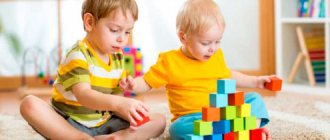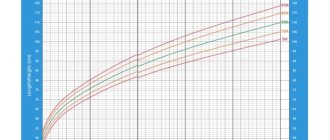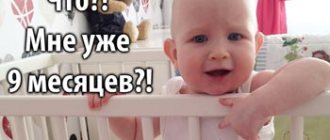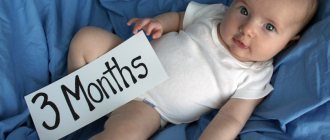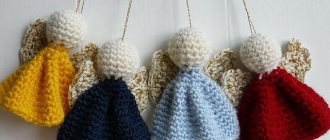Problem areas and moments.
H
Common problems at eight months that can be eliminated with massage and gymnastics are the formation of an incorrect motor stereotype, especially when crawling on all fours (the baby may place his leg incorrectly when crawling, or sit with a round back, make unnatural or non-standard movements when performing any motor acts). Problem areas for a child at 8 months are most often the back (may be weakened), legs (possible residual hypertonicity, or lack (weakening) of support), arms (the baby’s arms often need to be strengthened).
Massage, gymnastics for a 10 month old baby
At 10 months, the baby is actively preparing to go on his own. He already stands well with support, can sit for a long time without support and at the same time make turns of the body, play with both hands, the child generally crawls at the “speed of sound.” The baby can even walk either on his own along the support or with the support of the parent’s hands. Teach your baby to climb onto a sofa or chair on his own, and also to get off of them correctly, butt first, so as not to fall and break his nose. Show your child a variety of movements that he can already perform. For example, you can build an obstacle course at home that you have to climb or walk through. Teach him to step over something, climb 1-2 steps (until the baby can handle more), crawl through a tunnel (a special one for children or one built from chairs), a ring. A great fun activity for a child at this age is dancing. Children at 10 months usually have excellent hearing and are always in a good mood. Choose tunes that he likes, it can be light modern music, children's songs or classical melodies, for example, Strauss waltzes or works by Mozart, Chopin. All the children dance differently, some sway from side to side, others nod to the beat of the music, others perform springy squats, etc. Dance with your baby, if he already walks with support from one arm, teach him to make turns, you can add hand movements: claps or palms, flashlights.
Massage, gymnastics for a 10 month old baby – Set of exercises
1. We start gymnastics by crossing our arms according to the previously known pattern. Then you can immediately perform the “boxing” exercise by placing rings in the child’s hands. The exercises can now be performed not only lying and sitting, but also standing. Now lightly massage your baby's hands.
2. Sliding steps, cycling and foot massage. Remember that we start and end any massage with stroking, we perform it from the bottom up, i.e. from foot to thigh.
3. Turns from back to stomach through left and right sides. Now massage your back and buttocks.
4. Leg raises. Make sure your child's legs are straight at the knees. The child can already perform this exercise on his own; it is good for strengthening the abdominal muscles.
5. Squats from a lying position.
6. “Sit down and stand up.” Do squats, while the baby leans on your hands. When the baby masters this exercise well, you can put rings or toys with a round handle in his hands. This complicates the exercise, because now the baby needs to hold the support tightly; when he holds on to your hands, you fix him.
7. Also try to do 1-3 exercises with sitting down and standing up with support from only one hand.
8. Bend forward. Place the child with his back to you and fix his legs and pelvis, ask him to lean forward and pick up the toy from the floor. Perform the exercise 2-4 times.
9. Crawling. Remember that crawling is not just a way for a child to move, but an excellent exercise for strengthening all muscle groups. If the baby is already insistently demanding your hands to take a vertical position, attract him with a game. Make an obstacle course that needs to be overcome, crawl along with the baby in a race, by the way, this is a great exercise for mom too.
10. Walking. All kids now love to walk by the hand, because this way they can explore the world. Complicate the movements, help your baby learn to squat, step, and turn from a standing position. Encourage your baby to walk with support from one hand, not two. In this case, the baby will need to learn to maintain balance.
11. Bridge from a supine position. Hovering from a prone position.
12. Wheelbarrow. This is walking on your hands. The baby lies on his stomach, you raise his legs low, and the baby stands up in his arms and performs moving movements with them at your request. You can encourage your baby to walk with a toy lying at a distance in front of him. Perform the exercise 2-3 times. Although it is difficult, it is very useful, as it develops all muscle groups well.
Warning symptoms to watch out for!
If a child at 8 months stands on his toes and cannot put his feet on his feet at all. In these cases, a relaxing massage is needed on the lower extremities with an emphasis on the distal parts (foot, calf muscle). The child, standing, curls his toes. Also in such a situation, a relaxing foot massage is needed. A child at 8 months does not roll over from back to stomach. This is a delay in motor development, and a serious one at that. This often happens, of course, with pathology of the nervous system, but occasionally there are children who need to be properly stimulated to take active action. Those. There is no pathology, but for reasons that are not always clear, the child is not active. (It is possible that the parts of the brain in which the centers of motor activity are concentrated take a long time to mature). Generally speaking about the motor (motor) development of children, it can be noted that this happens quite often, that the baby, in terms of age/ability (skills), is already 2-3 steps behind, and after a course of massage in combination with gymnastics, he begins to have such progress that not all parents are ready for this, the child begins to roll over, crawl, and climb everywhere literally in 1-2 weeks. But it is better not to lead to such delays, but to massage children according to their age.
The specialists at the Happy Baby Children's Massage Center are always happy to help restore or maintain your baby's health! Call!,
A set of exercises on a fitball, designed for children from 6 months to 1 year.
So, your baby is already six months old. He still cannot do gymnastics on his own, but the issue of the child’s physical development is always relevant for parents. First of all, you should decide what you want to teach your child, what skills and abilities to instill and reinforce?
Each child goes through his own developmental path. It is impossible to evaluate his achievements based on some universal criteria. But still, in order to give an objective assessment of the baby’s development, it is necessary to take into account specific guidelines, and determining the degree of error is already the task of the pediatrician.
6 months
In the sixth month, the main achievements are considered to be the first attempts to sit down, but the back muscles are not yet strong enough to support the body, so the child leans on his hands, trying to somehow stay in a sitting position. Lying on his stomach, the baby can raise his body with straightened arms, resting on his palms. Having become interested in any object, he picks it up. The formation of the arch of the foot begins: the baby increasingly stands on a full foot and bounces in place with great pleasure. Therefore, it is necessary to support the baby under the arms.
7 months
By the seventh month, the baby is already getting up on all fours, crawling and backing freely. Sits confidently. Sitting independently, tilts and straightens the torso. Reaches for his reflection in the mirror, looks with his eyes and finds large objects called adults. Starts banging the toy against the back of the crib. Often throws a toy on purpose. Every day he becomes more dexterous and more confident in his control of his body.
8 months
8-8 months old baby, clinging to the crib, gets up and sits down on his own. Tries to clap his hands. Trying to walk with the support of his hands. Facial expressions become varied; interest and surprise arise when a new toy or an unfamiliar face appears. He looks for the object he needs and persistently strives to get it. Plays a lot with toys: examines them, taps one against the other, tries to throw them down, etc.
9 months
Tries to stand without support. Walks independently, holding onto support, rises and stands up from any position. When crawling on a flat surface, it climbs onto a pillow, bolster, etc. Performs quite complex actions: sorts through cubes, collects small objects; fulfills simple requests: “Give me a pen,” “Wave your pen,” “Goodbye,” etc. He prefers to play with toys while sitting. Looks for a fallen or hidden object, finds things located in different places, remembers their names. He remembers his name, turns his face to the one who calls him. Understands the word “no”. Captures not only intonation, but also the meaning of individual words (“give”, “throw”, “on”, “go”, etc.). Distinguishes the size, color, shape of objects.
10 months
By the tenth month, the baby rises on his own and stands without support. Can walk holding a hand or a stroller. Does not give away the toy he likes, imitates the movements of adults well. Begins to pronounce simple words. Names surrounding objects and animals in separate syllables.
11 months
By the eleventh month, the baby is already well oriented in space (stands up, sits down, bends down, walks with the support of his hand). Knows the names of many objects and shows a certain toy, parts of his body, etc. Fulfills many requirements, and shakes his head in denial. Coordination of finger movements increases noticeably (holds the toy tightly, crumples and tears paper).
12 months
The child is already walking independently; suitable if his name is. Squats and straightens without support; bending down, can pick up an object. Gives a toy if asked for it. Performs relatively complex tasks: opens the door, brings individual objects, toys. Likes to watch the movement of people and animals; reaches for moving objects and toys.
Is your baby just starting to crawl? Or is he already walking? Then play with him using a fitball. For this, it is best to use a ball with a diameter of 45–55 cm.
Attention! While practicing on the ball, it is prohibited to pull or hold the child by the hands (palms) or feet. This will help you avoid injury.
1.
The baby stands with his feet on the ball, trying to spring, jump and maintain balance. Be sure to hold the baby by squatting (from the side of the child’s back), because his coordination and balance are not yet sufficiently developed.
2.
The child lies with his back on the ball, his arms are spread to the sides and hang down. Hold your baby in this position: let his muscles rest.
3.
The baby lies on his stomach on the ball. Holding the back, rock the child forward and back, and then stretch his arms forward as far as possible. Your task is to ensure that the baby touches the floor with his hands when moving forward, and when moving backwards, makes such touches with his feet.
4.
Lying with his stomach on the ball, the baby hugs it with his palms. Hold your child's shins with both hands. Roll the ball back, pull the baby towards you, bend your knees. Roll the ball forward and straighten your baby's legs.
5.
Place your baby on the ball with his right side. Holding the child by the shin and forearm, roll him to the right and left several times. Repeat the same on the other side.
6.
Place the child with his stomach on the ball and hold it lightly with your hands. Tilt the ball to the right, then to the left, encouraging the baby to stay on the ball and extend his hand to the floor in the direction where you tilt the ball.
7.
Place several toys in front of the ball at a distance of 40 cm. Place the child with his stomach on the ball, facing the toys. Hold the baby with your hands and push him forward. When the baby rolls over to the other half of the ball, he will be forced to lean firmly on his hand. Moreover, he will try to lean on only one hand, and with the other - to get the toy.
8.
The ball should be inflated to 2/3 of its volume. Place your baby on it, facing you so that he literally falls into the hole. The child should be held firmly by the legs. Tilt the baby in different directions: forward - backward, right - left, etc. The child will perform movements that help him maintain balance and stay upright on the ball.
9.
Alternately hold your baby's right or left leg with your hand so that he hits the ball with only one leg.
10.
The child stands on the floor, hands on the ball. By pushing the ball forward, the baby moves around the room.
Gymnastics for an 8 month old baby
Gymnastics for an 8-month-old child is an integral addition to massage. It is better to do it every morning before meals so that it becomes a habit. If you are already doing gymnastics, improve the existing exercises, but now be sure to pronounce all the actions, focusing on parts of the body. If exercises are being done for the first time for an 8-month-old child, we will give you some recommendations. All exercises are designed to stimulate the baby’s motor skills, they will help him improve crawling and quickly begin to walk on his own.
Here are some good gymnastics exercises that you can do daily:
- Crossing your arms over your chest, bending them at the elbow.
- Roll over from back to stomach (baby can already do this on his own with a little help from you).
- Kneading the feet and palms, including each finger (use nursery rhymes).
- Exercises for legs: in a lying position, bend the child’s legs at the knees and straighten them at a right angle relative to the body.
- Sitting the child up from a supine position, including standing up. To do this, you need your baby to grab your index fingers with his fists. In the first days, you can support his hands with your own hands.
- Crawling after a toy (relevant for those who crawl poorly or have not yet learned this skill).
- Stepping and walking. Place your baby on his feet and show him how to walk by bending his knees.
- Fitball exercises.
It's no secret that children develop most rapidly in the first year of their lives. After all, in such a short period of time they need to learn a huge number of things: sit, walk, hold various objects with their hands. Yes, a lot more. But in the very first months of his life, the baby is just adapting to a world that is still foreign to him. Some newborns can sleep 20-22 hours a day, so there is simply no time left for independent full-fledged training of the muscular system.
That is why the topic of today’s article will be massage and gymnastics for children under one year old. How exactly is it best to perform such a procedure, why is it needed and what benefits can it bring to the child? This is what we will talk about.
